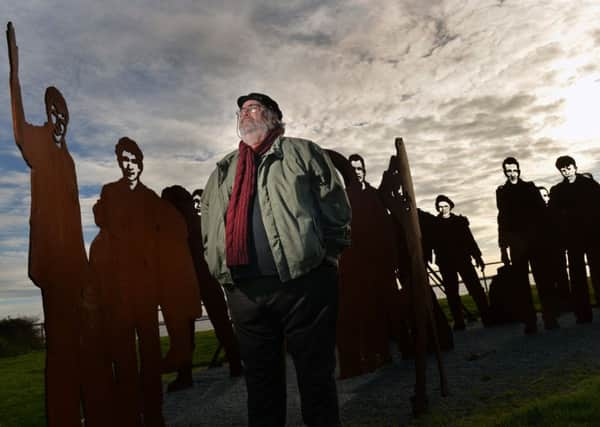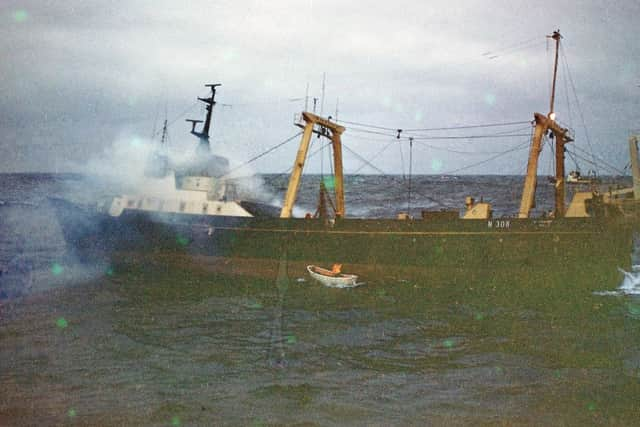Honouring forgotten story of '˜the quiet disaster'


When a fireball explosion ripped through the supertrawler St Finbarr, killing ten men, it took two days for the full story to filter back to the desperate waiting families at home.
St Finbarr “was the most modern trawler ever purchased by the Hull fleet” – £12m in today’s money – says author Brian Lavery. But it was also dogged by electrical problems and it came to grief, on its 13th trip in a gale on the Grand Banks, the same fishing grounds immortalised in the biographical disaster film The Perfect Storm.
Advertisement
Hide AdAdvertisement
Hide AdThe fire broke out in the early morning in an empty cabin in the crew’s accommodation, melting cables and letting off a powerful inflammable gas. The skipper Tommy Sawyers was sending a Mayday when he was blown out through the wheelhouse windows – a melted telephone receiver still in his hand. Half-dressed men scrambled onto a freezing – and burning – deck.


While the captain, mate and chief engineer stayed with the ship, the men were ordered to abandon ship, getting into a life raft, which was pulled to another stern trawler in an amazing feat of seamanship. But two of the oldest men in the raft, Tommy Gray and Harry Smith (inset), died when they fell into the freezing sea, as they tried to get up a dangling rope ladder to safety.
The Luckiest 13 by Dr Lavery follows his bestseller The Headscarf Revolutionaries, which charts the struggles of women from Hull for better safety at sea following the Triple Trawler Tragedy of 1968, in which three ships sank in weeks, with a loss of 58 lives. Just one man survived. Had the disaster on board the St Finbarr happened later, says Dr Lavery, it would have been the “Quadruple Trawler Tragedy”.
As it was, a Christmas news blackout meant 25 families did not know if their loved one was alive or dead for two days and the Triple Trawler Tragedy “wiped it out of public consciousness”. The ship had been delayed leaving port three times and one of the crew, Brian Williams, backed out.
Advertisement
Hide AdAdvertisement
Hide AdDr Lavery said: “Bad things happen in threes. Fishermen are superstitious – it is easy for us to laugh but being constantly in the shadow of death it becomes more understandable.”


Mr Williams and his two brothers were all later to die tragically at sea. Gavin Gray’s father, Tommy Gray, was the radio operator on board. Hugely respected, he was “one of the best”, having qualified aged just 17, and going on to serve with distinction in the Second World War.
Mr Gray said: “We found out from the TV. They said there was a fire and people said: ‘Don’t worry, it’s not your Dad.’
“It was about 30 hours before we knew he was dead. It was tough for my poor mum.
Advertisement
Hide AdAdvertisement
Hide Ad“There was a commemoration service afterwards, the whole of Hessle Road came out, people were showing great respect. I was just numb.” He added: “I appreciate the sympathetic way Brian has told the story and I am pleased it is coming to notice after so many years.”
Patrick ‘Paddy’ Tognola, the last surviving member of crew, now lives in Withernsea. He recalls waking up to smoke, and getting out with two shipmates via the engine room, and being in the liferaft, which was full of water. Despite being promised he would get full pay when he got home, he got nothing.
He carried on fishing afterwards and later went into oil rigs, which was “a lot better”.
Fishing, he says, was “dangerous, hard work”.
For landlubbers, the book vividly creates what it is like to be tossed about for days “like a tiny sponge in a gigantic freezing slushy jacuzzi”.
Advertisement
Hide AdAdvertisement
Hide AdIt recalls distant water fishing in its heyday, when fisherlads, the “cowboys of the deep”, wandered like “Serengeti” herds to Hessle Road pubs in pastel suits and 20-inch bellbottoms.
The book is also a love-story of a teenage deckhand Tony Harrison and his girlfriend and later wife Jill Harrison, (now Jill Long) that ended with a heart-rending twist.
A book signing will take place at Waterstone’s in Hull at 2pm on November 25, before an official launch at Middleton Hall at the University of Hull on December 15.